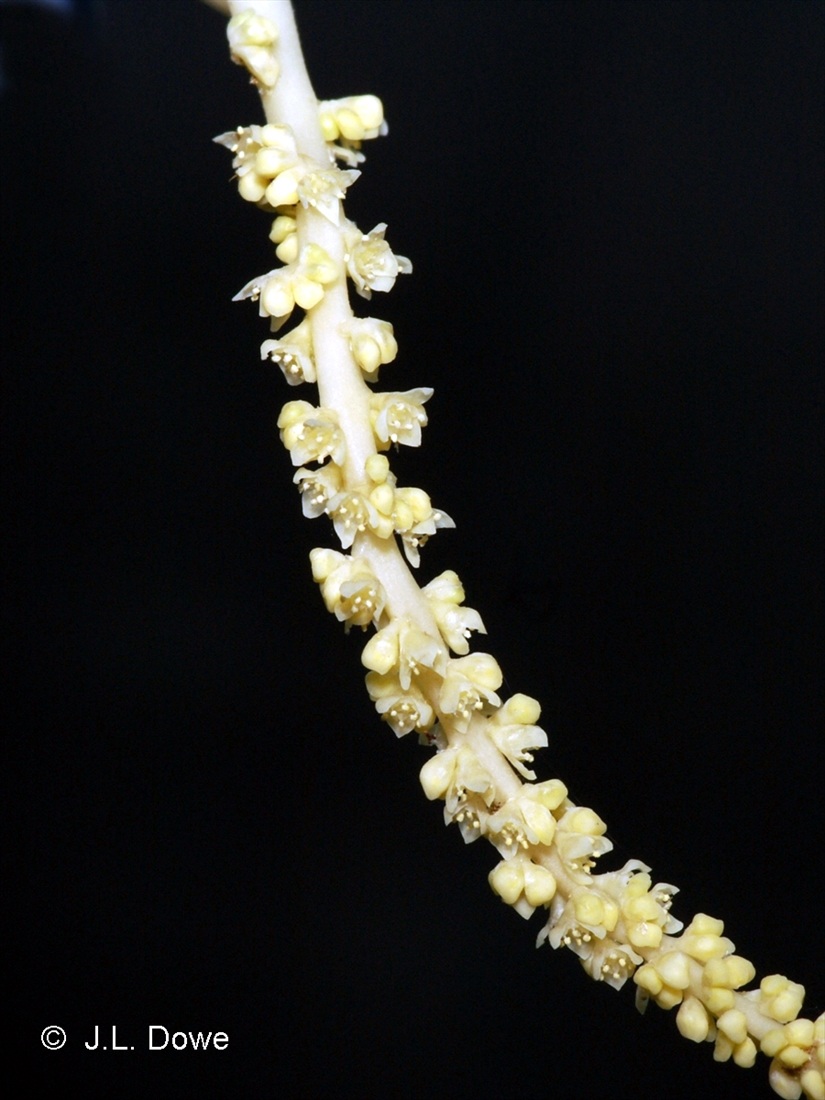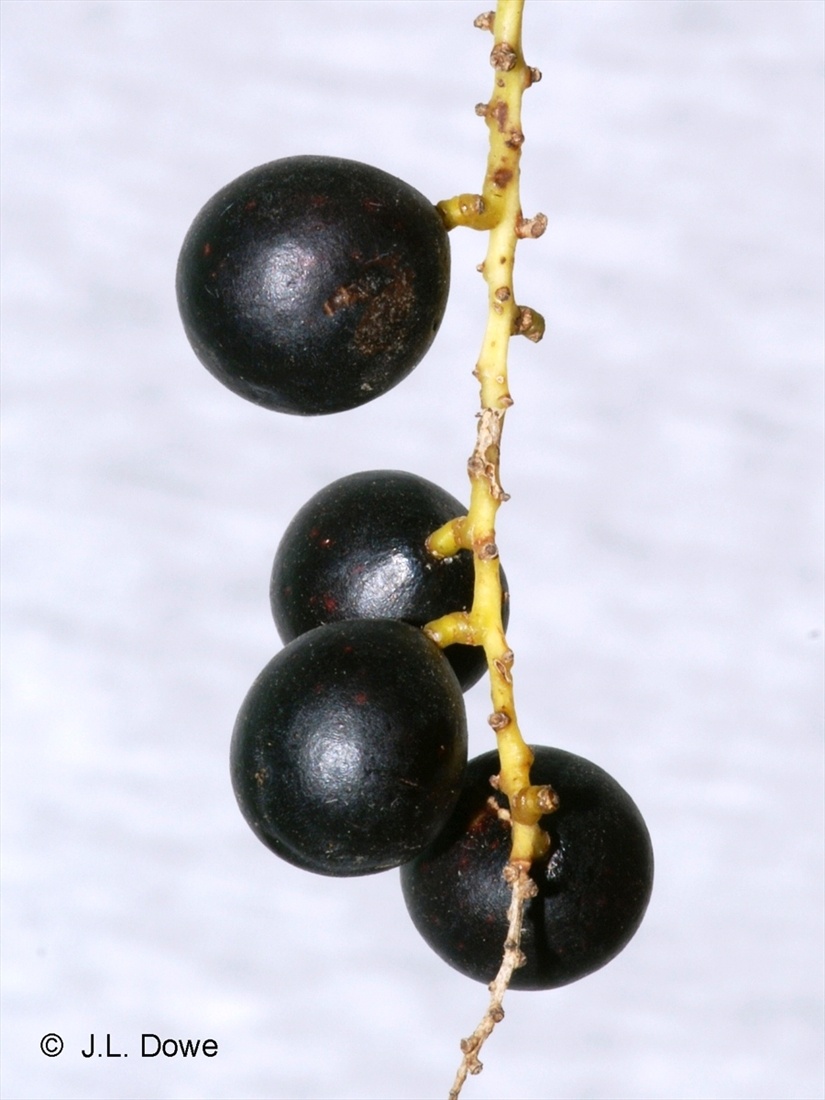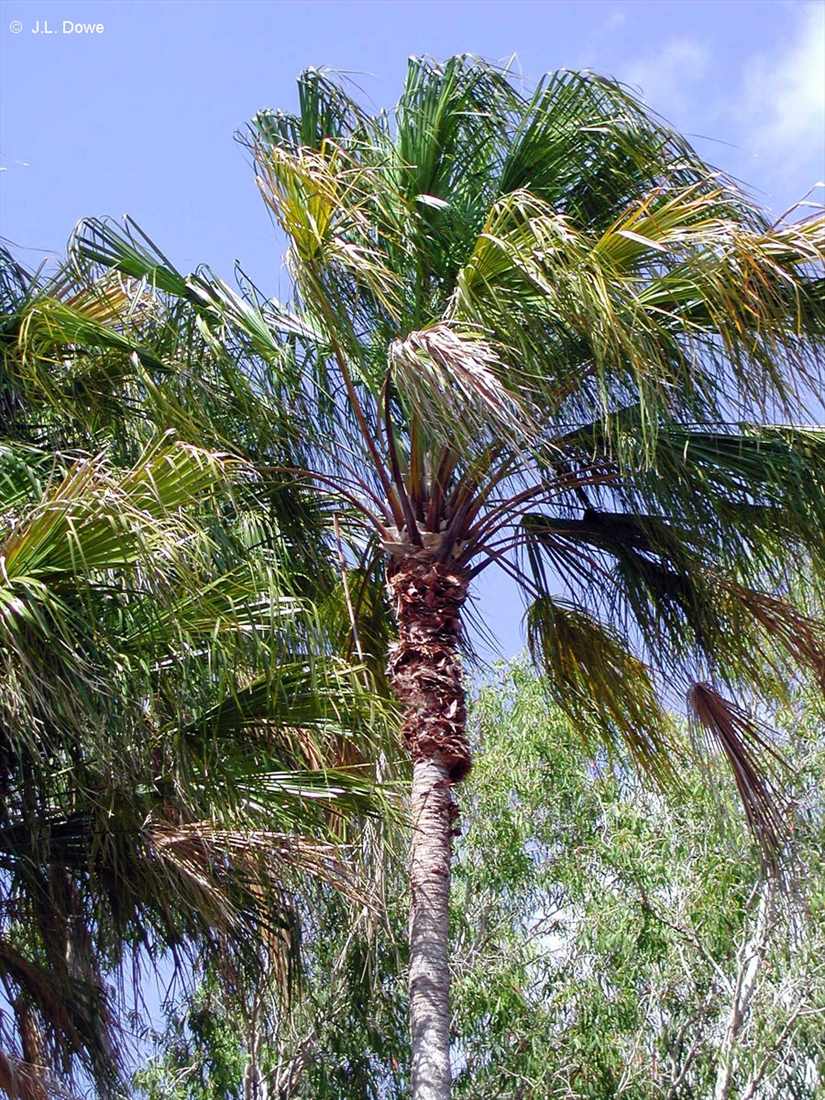Australian Tropical Rainforest Plants - Online edition
Livistona drudei F.Muell.





Mueller, F.J.H. von (1878) Fragmenta Phytographiae Australiae 11(89): 55. Type: Lectotype: Queensland: Rockingham Bay, Dallachy (?), Sep 1865. (MEL).
Cabbage Palm
Trunk solitary, to ca. 20 m high, 15-20 cm diameter at 1 m above ground, broadening from a point ca. 1.5 m above ground into a flared cone to ca. 30 cm diameter sitting on a large root-mass up to 80 cm diameter and 40 cm high, reducing upward to a final constant diameter of 17-23 cm. Surface of old trunk pale grey, very smooth, waxy-whitish in patches; vertical fissures close, shallow, fine, not very prominent; petiole-stubs absent. Plants functionally male or female.
Crown rather open, ± globose, consisting of 30-60 leaves with long, weak, arching petioles, the lowest leaves radiating ± horizontally or moderately pendulous but with petiole bases strongly ascending and imbricated, and pendulous segment-lobes. Ligules prominent, pale straw-coloured, persisting as papery plates in upper half of crown, woolly-tomentose with narrow, deeply laciniate, contorted whitish scales. Petiole 160-230 cm long, 15-25 mm wide, flattened-triangular in cross-section with very rounded keel to unequally biconvex, with thin upturned edges. Margins virtually unarmed on upper half, grading randomly into pricklets; toward base armed with mostly retrorse, narrow, slightly falcate, pungent, shiny dark brown prickles to c. 7 mm long. Surfaces green, deep dull purplish toward base, ± smooth, hardly striate, the upper with distinct median zone of fairly deep, narrow pits abruptly incised into surface, closely crowded and frequently confluent; the lower more closely and evenly pitted but pits shorter, broader, frequently confluent. Hastula ± flat or shallowly channelled, somewhat warped; base V-shaped and cuspidate to shallowly 3-lobed; rim at 25-35° to costa, to 40 mm wide, subacute, entire except for (commonly) 1-2 deep clefts. Lamina 100-140 cm long, ca. 0.2 mm thick, strongly costapalmate, somewhat elongated with the undissected portion rather long and narrow, the base ± truncate or with broad sinus, fairly tough, not splitting readily; rather strongly contorted with 1 major and 1 smaller adaxial undulation either side of the almost straight costa and lower edges strongly involute, with lowermost few segments resupinate. Segments 33-35 either side of costa; largest segments 20-27 mm wide, free for 60-70% of their length, bifurcated for c. 60% of free length, the lobes moderately diverging, evenly tapering into finely attenuate but not threadlike, soft, flexuous, necrotic apices; in some specimens secondarily bifurcated to a depth of 8-15 cm, the two parts of unequal width. Intersegmental appendages 5-10 mm long, somewhat stiff and brittle, white. Abaxial ribs bluntly square-edged to quite rounded; adaxial ribs semi-elliptic to triangular. Major longitudinal veins 8-9 on either side of abaxial rib, prominent above, less prominent below; transverse veins evident above, moderately prominent below. Surfaces deep green, upper glossy, lower rather dull, quite glabrous except for inconspicuous pale brownish narrow scales on rib bases on underside.
Inflorescences slightly shorter than to longer than petioles. Partial inflorescences 7-8, short relative to rachis, each branched to 3 further orders; rachillae 0.5-8 cm long, 0.5-0.8 mm thick, minutely pubescent, closely striate. Rachis bracts flattened-cylindrical, to ca. 2 cm diameter, smooth but rather loose, coriaceous, rather tough, when dry pale yellowish-brown to darker reddish-brown, closely striate, sparsely sprinkled with minute white appressed scales, glabrescent post-anthesis; bract apices narrowly triangular, acute to slightly acuminate, variably fringed with narrow white scales. Flower-clusters 0.5-4 mm apart, 2-5-flowered; cluster axis 0.3-1.0 mm long, cylindrical to flattened, rather slender. Cluster-bract 0.5-1.0 mm long, triangular-acuminate or sparsely fimbriate, very delicately membranous except for fleshy base. Bracteoles approx. 1 per flower, similar to cluster-bract but shorter and often rounded. Flowers ca. 2.2 mm long, funnel-shaped. Anthopodium 0.2-0.3 mm long, cylindrical, rather slender, only slightly recessed at base. Sepals ca. 1.5 mm long, connate for 30% of their length, appressed to petals, concave, membranous toward margins, free portion narrowly triangular-ovate, subacute. Petals 1.7-2.0 mm long, connate for 25% of their length, slightly concave, fleshy-textured; broad-ovate, acute to obtuse with very thickened apex, base with minute retrorse, rounded auricles; inner face with 2 deep, narrow cavities close to margins and a less distinct median cavity. Stamens ca. 75% as long as petals, connate for almost half their length; filaments very fleshy, broadly ovate, hardly shouldered, abruptly narrowed into a quite short, slender apex.
Features not available.





